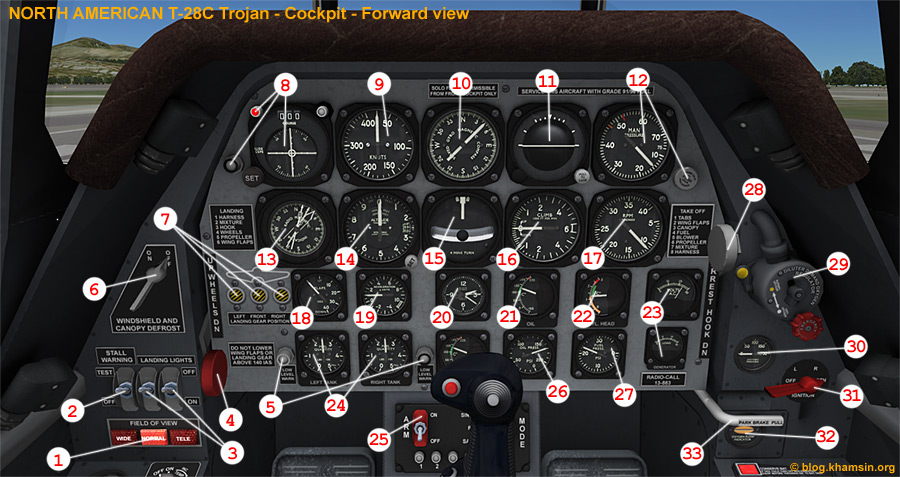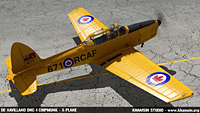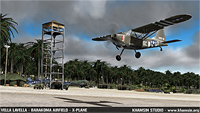INSTRUMENTS
COCKPIT - FORWARD VIEW (TYPICAL)

- 1. Field Of View SELECTOR This allows you a one-click toggling from "Wide" to "Normal" or "Tele" field of view. Very useful when approaching a carrier for instance
- 2. STALL WARNING TEST SWITCH This switch is intended, IRL, to test the warning stall bipper. It's useful in game to disconnect the autopilot.
- 3. LANDING LIGHTS SWITCHES The Left and Right landing lights can be operated separately. NB : the "ext" switch, on the left panel, must be ON for the landing lights to light on.
- 4. GEAR HANDLE Guess by yourself what it's for...
- 5. FUEL LOW-LEVEL WARNING LIGHT These lights will turn on when there is 30mn of fuel left (depending on your attitude)
- 6. WINDSHIELD AND CANOPY DEFROST - CONTROL HANDLE
- 7. GEAR LOCK INDICATOR This does not display the position of the gears, but wether each gear is LOCKED or not.
- 8. ILS & Runway Heading, BEACON MARKER The ILS is automatically controlled by the NAV1 frequency you dialed on the navigation panel. The up-left light turns on when a glide-slope is caught, the up-right light turns on when a path is caught. The lower_left light turns on when the plane flies over a beacon marker (middle). The digital display gives the absolute heading of the LOC the ILS is tuned to, tha is, the heading of the runway (as for carier, it's not the carrier headin, but carrier heading minus 8 degrees)
- 9. AIRSPEED INDICATOR In knots. The main speeds to be known are : Vref=59kt (no payload, full flaps), 90kts (take-off speed, V2), 140kts (max speed with gear down or flaps down), 185/225 kts (cruise speeds), 343kts - Vne.
- 10. COURSE INDICATOR
- 11. GYRO HORIZON INDICATOR
- 12. MANIFOLD PRESSURE INDICATOR AND DEPRESS BUTTON You should care about this one. When flying, never drop below 25 inches, never set more than 52.5 inches. Max continuous is 47 inches, up to 52.5 for 5 minutes, but you should fly at atmospherical pressure + 5 inches most of the time. That's around 35 inches at sea level, when cruising, or 30 inches with high-blower above 15000ft.
- I3. RADIO MAGNETIC INDICATOR The double arrow is driven by the autopilot heading setting. The needles #1 & #2 are driven by the NAV1 and NAV2 frequencies, so #1 points toward the carrier if the NAV1 is set to 108.10
- I4. ALTIMETER
- I5. SLIDE INDICATOR
- I6. VERTICAL SPEED INDICATOR
- I7. RPM GAUGE The engine can withstand up to 2700rpm for a short period of time, but the usefull range stretch from 1600rpm (high altitude cruise) to 2400 rpm (Climbing)
- I8. FLAPS DEPLOY INDICATOR Indicates the actual position of the flaps. When the needles is below the "up" position, flaps are locked. Maximum allowable speed with flaps deployed is 140 knots.
- 19. ACCELEROMETER Never exceed 5G. Don't forget that stall speeds depend on the G-factor.
- 20. CLOCK
- 21. OIL TEMPERATURE GAUGE
- 22. CYLINDER HEADS TEMPERATURE GAUGE This one is of major interest. Make sure the needle never goes outside the green arc !
- 23. GENERATOR VOLTMETER
- 24. FUEL QUANTITY GAUGES The plane carries up to 1062 lb of fuel, allowing a rough 4 hours airborne.
- 25. ARMAMENT PANEL To release bombs, first set the armament selector to "ON", then set a mode : single, pair, salvo.Now press the action key (space is defaut)
- 26. OIL PRESSURE INDICATOR
- 27. FUEL PRESSURE INDICATOR
- 28. HOOK HANDLE The hook produces no noticeable drag.
- 29. OXYGEN DILUTER
- 30. OXYGEN PRESSURE GAUGE
- 3I. MAGNETO HANDLE
- 32. OXYGEN BLINKER
- 33. PARK BRAKE HANDLE
www.khamsin.org - © 2013



